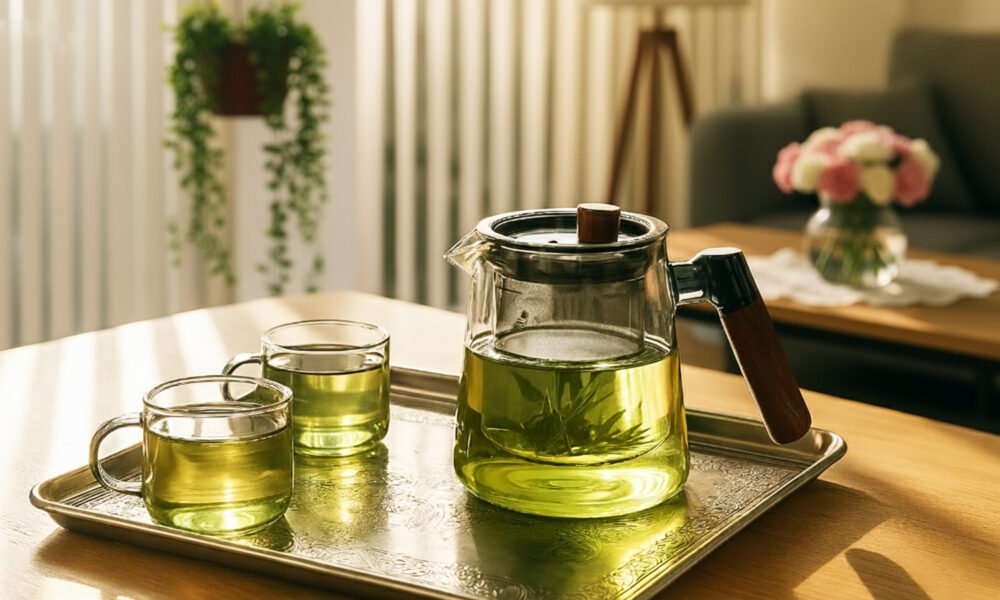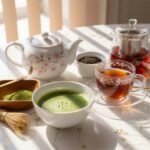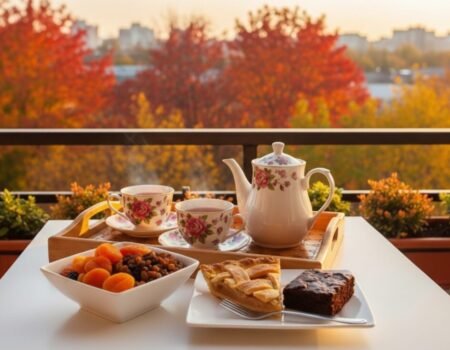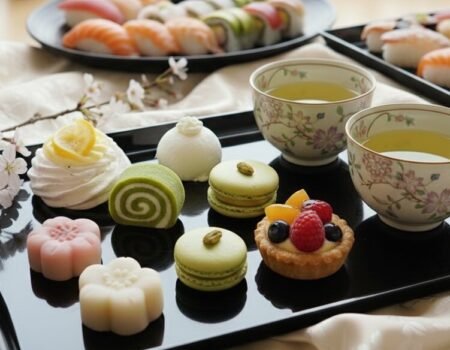
How to Brew Green Tea: The Ultimate Guide to Making the Perfect Cup
Index
Many people struggle with brewing green tea that tastes bitter or bland instead of fresh and flavorful. Green tea contains less caffeine than most other teas and much less than coffee, making it a popular choice for those seeking a gentler energy boost.
This guide will walk you through each step of brewing green tea correctly, from water temperature to steeping time. Get ready to transform your tea experience!
Key Takeaway
- Use water between 160°F to 180°F /71°C to 82°C for green tea to avoid bitterness that comes from scorching the leaves with boiling water.
- Steep green tea for only 1-3 minutes, as longer times release too many tannins that create harsh flavors.
- The standard ratio is 2 grams of tea leaves (about 1-2 teaspoons) per 6-8 ounces (~175-250 ml) of water for balanced flavor.
- According to Chinese legend, green tea was discovered by Emperor Shennong in 2737 BC, although historical records of tea drinking appear much later. Green tea was later introduced to Japan by Buddhist monks in the early 9th century.
- Glass teapots work best for green tea, allowing you to watch the leaves unfurl while keeping proper brewing temperature.
What Is Green Tea?

Green tea comes from the Camellia sinensis plant, the same species used for black and oolong teas. Its story in Chinese culture begins with the legend of Emperor Shennong discovering it in 2737 BC, though verifiable records date from much later.
Unlike black tea, green tea leaves are not oxidized during processing.
Producers pick the leaves, wither them for about 13 hours, then heat them to stop oxidation. This heating preserves the natural compounds and creates that distinct green tea flavor.
Buddhist monks brought green tea to Japan in the 9th century, where it became central to their culture. The drink finally reached Europe in the 17th century, gaining fans worldwide.
Green tea stands out for its health benefits and unique processing method. The leaves go through five main steps: picking, withering, heating, rolling, and drying. This careful process keeps the leaves green and maintains their natural antioxidants.
These compounds can help with heart health, and mental focus. Japanese green teas like Sencha and Matcha differ from Chinese varieties like Longjing and Gunpowder in taste and appearance.
Each type offers its own flavor profile based on growing region, harvest time, and processing techniques.
Essential Tools for Brewing Green Tea
The right tools make all the difference when brewing green tea at home. A good teapot, proper measuring spoons, and a reliable thermometer will help you create that perfect cup every time.

Teapots, Infusers, and Strainers
Glass teapots with built-in infusers offer a perfect way to watch your green tea leaves unfurl while brewing. These vessels allow you to monitor the color and strength of your tea, making them ideal for beginners learning proper steep times.
Ceramic teapots work best for black and oolong teas, while glass options shine with white and herbal varieties. Cast iron teapots hold heat longer, creating a more consistent brew throughout your tea session.
Mesh infusers give tea leaves room to expand fully, releasing maximum flavor into your cup. Silicone alternatives provide easy cleaning and durability for daily use. Many tea lovers also enjoy reusable tea bags as an eco-friendly option that reduces waste while still delivering great taste.
Your choice between these tools affects how flavors develop in your cup, so match your equipment to your favorite tea type for best results.
Choosing the Right Teaware
Now that we’ve explored various brewing tools, let’s focus on selecting the perfect teaware for your green tea experience. The right vessel can make a huge difference in how your tea tastes and how much you enjoy the brewing process.
Material & Design Considerations
Material Selection
- Porcelain teapots hold heat well and don’t absorb flavors, making them ideal for tasting different tea varieties.
- Glass teaware lets you watch your tea leaves unfurl, adding a visual element to your brewing process. This clear material works well for displaying the bright green color of quality leaves.
- Traditional Kyusu teapots feature a fine filter fixed at the spout, perfect for Japanese green teas with smaller leaves. These specialized pots trap leaf particles while allowing the full flavor to develop.

Functional Design Elements
- Heat retention affects steeping quality. Thicker ceramic walls keep water at the right temperature longer than thin materials, helping maintain the ideal brewing conditions.
- Lid fit prevents heat loss during the crucial steeping period. A snug-fitting lid maintains the proper temperature for extracting the best flavors from your tea leaf.
- Strainer quality impacts your final cup significantly. Fine mesh strainers catch tiny leaf particles that might make your tea taste bitter or astringent.
Practical Usage Factors
Size & Capacity
- Size should match your drinking habits. A small 8-ounce teapot works best for solo drinkers, while 16-24 ounce pots suit sharing tea with guests.
Daily Use Considerations
- Handle comfort makes a practical difference in daily use. Test how the handle feels in your hand before purchasing, as you’ll grip it often during brewing.
- Ease of cleaning should factor into your decision. Teapots with wide openings allow you to remove used leaves and scrub the interior without struggle.
- Price range should align with your tea habits. Invest in better teaware if you drink green tea daily, while occasional drinkers might start with more basic options.
Preparing for the Brew

Getting ready to brew the perfect green tea starts with picking the right leaves. Fresh, high-quality tea leaves make all the difference in your final cup.
Selecting High-Quality Green Tea Leaves
Quality green tea starts with the delicate bud and top two leaves of the Camellia sinensis plant. Fresh leaves appear bright and vibrant with a sweet, grassy scent that signals proper handling.
Look for whole tea leaves rather than broken pieces, as intact leaves preserve more flavor compounds and result in a better cup. Chinese green teas often have long, needle-shaped leaves fired in woks, while Japanese varieties like Sencha have flatter, steamed leaves with a deeper green color.
Tea freshness matters greatly since green tea loses flavor quickly after processing. Buy loose leaf green tea in small batches from trusted sources who can tell you the harvest date and origin.
Major tea producers include China and Japan, each with distinct processing methods that create unique flavor profiles. The best green teas will list specific regions such as Longjing or Gyokuro, indicating higher standards and traditional crafting techniques.
Measuring the Proper Tea-to-Water Ratio

Now that you’ve selected your green tea leaves, getting the right balance between tea and water makes all the difference in your cup. The standard rule for most green teas is 2 grams of leaves per 6 ounces (~175 ml) of water.
This ratio creates the perfect strength without bitterness. Tea leaf size matters too – larger leaves might need more space to expand and release their flavors fully. A basket-style infuser gives your leaves room to unfurl properly.
For those without a scale, measuring by volume works well. Use 1-2 teaspoons of tea leaves per 8 ounces (~250 ml) of water in your teapot. Adjust this amount based on your taste preferences and the specific green tea variety.
Japanese teas like sencha may need less, while Chinese gunpowder green might require more due to its tightly rolled leaves. The proper ratio ensures you’ll taste all the subtle notes that make green tea special.
Heating the Water
Getting the water temperature right makes or breaks your green tea. Too hot and you’ll scorch the leaves, leaving a bitter taste that ruins the delicate flavor.
Ideal Water Temperature Range (160°F to 180°F / 71°C to 82°C)
Green tea requires specific water temperatures between 160°F to 180°F (71°C to 82°C) for optimal brewing. This temperature range extracts the delicate flavors without releasing too many tannins that cause bitterness.
Many tea lovers make the mistake of pouring boiling water over green tea leaves, which scorches the leaves and ruins the subtle taste profile. A kitchen thermometer offers the most accurate way to check your water temperature, but you can also watch for small bubbles forming at the bottom of your kettle as a visual cue.
The right temperature brings out the sweet, grassy notes that make green tea special. Japanese varieties like sencha often taste best at the lower end of the range (around 160°F), while Chinese types such as gunpowder tea can handle slightly hotter water (closer to 180°F / 82°C).

Your brewing vessel matters too—glass or ceramic teapots maintain heat well without affecting flavor. Let’s explore some practical tips for avoiding overheating your water in the next section.
Tips for Avoiding Overheating
Now that you know the ideal temperature range sits between 160°F to 180°F (71°C to 82°C), you need practical ways to avoid overheating your water. A digital thermometer offers the most accurate readings for perfect brewing.
If you lack this tool, try the visual method – water at the right temperature forms tiny bubbles at the bottom of your pot without creating a rolling boil. Many tea lovers use the “cool down” technique by bringing water to a boil, then letting it rest for 2-3 minutes before pouring.
Another simple trick involves mixing boiling water with room temperature water in a 2:1 ratio to quickly reach the target range. Overheated water extracts too many bitter compounds from tea leaves, ruining your cup.
Electric kettles with temperature settings eliminate guesswork completely. For travel situations, pour boiled water into a second cup first, allowing it to cool slightly before adding your tea leaves.
Steeping Techniques
Steeping your tea is where the magic happens in your brewing process. The right timing turns plain water into a flavorful cup that brings out the best in your green tea leaves.
Recommended Steeping Times (1 to 3 Minutes)
Green tea requires a short brew time of just 1 to 3 minutes for optimal flavor. The exact timing depends on which type of tea you’re using and your taste preferences. Japanese sencha might taste best with a 1-minute steep, while larger Chinese tea leaves could need the full 3 minutes to release their flavors.
Leaf size matters too – small particles infuse faster than long, needle-shaped leaves.
Most tea experts agree that timing your steep precisely helps avoid bitterness. Too short, and your cup of green tea will taste weak and watery. Too long, and it becomes harsh and astringent.
Using a simple kitchen timer can make a big difference in your tea drinking experience. For beginners, start with 2 minutes and adjust based on how you like the taste.

Common Mistakes to Avoid During Steeping
Steeping green tea seems simple, but small errors can ruin your perfect cup. Many tea lovers make these common mistakes without realizing how they affect flavor and quality.
Water Temperature & Timing Mistakes
Critical Temperature Control
- Water that’s too hot burns the leaves and creates harsh flavors. Keep water between 160°F and 180°F for ideal brewing results.
- Rushing the cooling process prevents full flavor development. Allow your tea to cool slightly before the first sip to appreciate all its notes.
Steeping Time Errors
- Steeping for too long creates bitter tea that loses its delicate flavor profile. Most green teas need only 1-3 minutes to release their best taste.
- Leaving tea bags or infusers in the cup after the steeping time continues the brewing process. Remove them promptly to stop extraction.
Tea Preparation & Handling Issues
Leaf Management
- Crowding the tea leaves prevents proper expansion and water circulation. Give your loose leaf tea enough space to unfurl completely in the infuser.
- Measuring incorrectly leads to weak or overpowering brews. Use about 1 teaspoon of loose tea per 8 ounces (~250 ml) of water for balanced flavor.
Physical Handling Mistakes
- Squeezing tea bags forces out bitter tannins that spoil the tea’s natural sweetness. Lift the bag gently without pressing or twisting it.
- Reusing leaves too many times diminishes the quality with each steep. Most green teas can be steeped twice before losing their character.
Water Quality & Equipment Choices
Essential Equipment Considerations
- Using tap water with high mineral content or chlorine affects the pure taste of green tea. Filtered or spring water makes a noticeable difference.
- Brewing in metal containers sometimes creates unwanted metallic flavors. Ceramic, glass, or clay teaware preserves the authentic taste better.

Enhancing the Flavor
While green tea has its own distinct flavor, it harmonizes beautifully with other ingredients, allowing for creative experiments. Try adding a splash of lemon juice, a drizzle of honey, or fresh mint leaves to create a profile that matches your mood.
Adding Lemon, Honey, or Mint
Fresh lemon slices add a bright, citrus zing to green tea that enhances its natural flavor profile. A small squeeze brings out hidden notes in sencha or longjing varieties without masking their subtle qualities.
Honey serves as a natural sweetener that balances any bitter edges, especially in stronger brews or if you’ve steeped the leaves a bit too long. Many tea drinkers find that raw honey works best, as it dissolves easily and complements the earthy tones of quality green tea leaves.
Mint leaves create a refreshing twist that works perfectly in both hot and cold green tea preparations. Simply add 2-3 fresh mint leaves to your cup during the final minute of steeping for a cooling effect.
This combination proves especially popular during summer months when iced green tea becomes a go-to beverage. The mint-tea pairing not only tastes great but also but also retains green tea’s valuable digestive and calming benefits.
Cold brewing offers another interesting method to extract different flavors from your tea leaves.
Experimenting with Cold Brewing
Cold brewing creates a smoother, less bitter green tea with unique flavor notes. Simply place 1 tablespoon of tea leaves in a clean pitcher with 12 ounces (~350 ml) of cold water and let it steep in your refrigerator.
Japanese green teas, such as Sencha and Fukamushi Sencha, typically require 3–8 hours of cold steeping to develop their full flavor, while other green teas may also benefit from this extended extraction time. This method works especially well with Fukamushi Sencha (7g per 12 oz / 350 ml) and Hojicha (3g per 12 oz / 350 ml), each developing rich profiles during their extended steep times.
The resulting tea stays fresh for up to three days, making it perfect for busy tea lovers who want to prepare batches ahead of time.
Your cold brew journey might start with traditional varieties, but don’t stop there! Many tea enthusiasts enjoy adding sliced fruit, mint leaves, or a touch of honey to their cold brews for extra dimension.

The lower temperatures bring out different compounds in the leaves, creating flavors you might miss in hot preparation methods.
Conclusion
Brewing green tea becomes simple once you master the basics. Start with fresh leaves, proper water temperature, and the right steeping time. Your choice of teaware matters too—a good pot or infuser makes all the difference.
Try adding lemon or mint for extra flavor, or experiment with cold brewing during hot summer days. With practice and patience, you’ll create the perfect cup that brings out all the subtle notes and health benefits this ancient beverage offers.
Now go ahead and brew your next cup with confidence!
FAQs
1. What is the best way to brew green tea correctly?
The best way to brew green tea depends on the type of green tea you’re using. For most varieties, heat water to about 175°F / 80°C (not boiling!) and steep the tea for 1-3 minutes. Japanese green teas like sencha need cooler water and a shorter brew time than Chinese varieties.
2. How much tea should I use per cup?
Use about 2 grams of tea leaves (roughly one teaspoon) per 8 ounces (~250 ml) of water. The amount may vary based on the particular tea and your taste preferences. Quality matters more than quantity.
3. Can I make iced green tea?
Yes, you can make refreshing iced tea using green tea. Brew the tea slightly stronger than normal, then pour over ice. Cold brewing is another option where you steep tea leaves in cold water for 6-8 hours in the refrigerator.
4. What are the health benefits of green tea?
Green tea extract can help with weight loss by slightly reducing body fat and boosting fat burning during exercise. It also supports heart health by improving cholesterol levels (lowering “bad” LDL and raising “good” HDL cholesterol) and may help lower blood sugar levels.
While these benefits are real, they tend to be modest – green tea is helpful but not a miracle cure.
5. How can I tell when my tea is ready?
Your tea is ready when it reaches a pale yellow to light green color. Taste the tea to check if it has developed the flavor you want. Remove the tea leaves promptly to prevent bitterness from over-steeping.
6. What’s the difference between sencha and matcha green tea?
Sencha uses whole tea leaves that are steeped and removed, while matcha is made from powdered tea leaves that you consume entirely. Sencha has a fresh, grassy taste, while matcha offers a richer, more intense flavor and higher caffeine content.
References
- https://weaverscoffee.com/blogs/blog/the-ultimate-guide-to-green-tea?srsltid=AfmBOoocXhnwoumpoyE_9daf7-Cqa-qv6YtkQ4Q4b3NmVEkraFqk5-SX (2024-06-22)
- https://www.thekitchn.com/how-to-brew-green-tea-cooking-lessons-from-the-kitchn-203091
- https://backyardbrew.com/blogs/tea/tea-brewing-accessories?srsltid=AfmBOoo0d9Uk0cwFbJQTm6M1ow7pNr9h6W21ojaVLCucr0w4VPrt9s5K
- https://www.hibiki-an.com/contents.php/cnID/61?srsltid=AfmBOoqo346wIzixSjeDP7p5ssZBOUeobuoC9YvzkBkoQyscII36ikG4
- https://www.herbsandkettles.com/blogs/tea-school/the-right-tool-for-the-right-tea-a-guide-to-which-teaware-to-use-for-each-tea-type?srsltid=AfmBOooKIjDttw8icJSJcES-Nk1WJx5OjExvI4EbM8uZZuh_ugARLzCc
- https://www.whittard.com/us/discover/tea-tips/a-guide-to-green-tea.html
- https://backyardbrew.com/blogs/tea/water-temperature-for-brewing-tea?srsltid=AfmBOopn86B0PXxJAd2ffbTmWNzQ8ASnBnLxZd4f12t-6nAG-MVXtmGn (2025-04-18)
- https://brewbuch.com/how-to-make-tea/ (2024-02-23)
- https://rishi-tea.com/blogs/journal/why-water-temperature-is-important-when-brewing-tea?srsltid=AfmBOoqfhaNPoNtXuKwkLWfVAo0UgQ1DH8BBrnh2w2b-kFuGn-9jtLn3
- https://www.artoftea.com/blogs/tea-101/recommended-steep-times
- https://tealeavz.com/blogs/tea-talk/10-mistakes-to-avoid-when-steeping-tea?srsltid=AfmBOorjINucTZpJPIUXAlXc5ZIQ0AwOqH5KJyaFdI2LLll0oj1bMKF5 (2024-02-26)
- https://mantechpublications.com/how-to-make-green-tea/ (2024-10-18)
- https://www.sugimotousa.com/blog/how-to-cold-brew-green-tea-and-why-you-should-do-it?srsltid=AfmBOor5voByppiJStCh7krZUuUJ1ElPvkIU5w661runsPuzr6kIjLfG
- https://www.sugimotousa.com/blog/how-to-cold-brew-green-tea-and-why-you-should-do-it?srsltid=AfmBOorYkzs6fooEwPSXgigsUWPhldZJ0QKWgNkHwR18evjTic_211Oe






